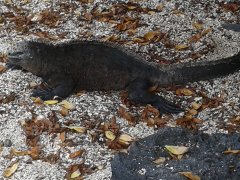 Charles Darwin’s birthday is today – his evolutionary theory is one of the cornerstones of anthropology: the study of humankind. It was in the Galapagos Islands, with their myriad natural anomalies, that Darwin developed what he called the theory of “natural selection, ” which forms the basis of evolutionary theory, in all the sciences.
Charles Darwin’s birthday is today – his evolutionary theory is one of the cornerstones of anthropology: the study of humankind. It was in the Galapagos Islands, with their myriad natural anomalies, that Darwin developed what he called the theory of “natural selection, ” which forms the basis of evolutionary theory, in all the sciences.
Darwin and Natural Selection
Darwin’s theory of natural selection rests on phenomena that are subject to direct observation and experimentation: In every species, there is a range of variation of specific traits (hair and skin color, for example.)
Not every individual in any given species reproduces. In a nutshell, Darwin’s theory states that those who do reproduce pass down their specific traits to their offspring. If a certain trait is more advantageous in a specific environment, then the carriers of that trait are more likely to survive into adulthood and to generate offspring than those who do not have that trait.
Cumulatively, over generations, the traits that are advantageous for a species will proliferate. Darwin originally termed this process “descent with modification.” By the late 1860s, he started to call it “survival of the fittest, ” a term that is very familiar to the contemporary ear.
 Darwin’s Finches
Darwin’s Finches
Perhaps the most significant evidence of natural selection that Darwin found on the Galapagos Islands was in the anatomy of the finches, whose variety piqued his curiosity. Darwin discovered that Galapagos finches have thirteen different kinds of beaks. Through careful observation and consultation with an ornithologist, Darwin began to understand that the difference in the size and shape of the finches’ beaks was due to their adaptation to a particular environmental niche.
Specifically, the different kinds of beaks are adapted to differences in the food supply. For example, in niches where insects are abundant, the finches have developed long, thin beaks which they insert into tree bark in order to extricate their prey. Whereas, in areas where nuts are abundant, the finches’ beaks are shorter and sturdier, allowing the birds to crack the nuts open more easily.
Adaptive Radiation
Adaptive radiation is another example of natural selection at work. Adaptive radiation refers to the process in which a species evolves rapidly to exploit an uninhabited environmental niche. This principle explains some of the variety in physical traits of human beings, even though we are all members of the same species.
Galapagos Marine Iguanas
One of the most interesting examples of adaptive radiation is the case of the Galapagos marine iguanas. The only marine iguanas in the world, they are on almost every island of the archipelago, and number between 200, 000 and 300, 000.
Anthropologists believe that these iguanas arrived on the Galapagos by “island-hopping” from Central American jungles: that is, they floated on rafts of vegetation that drifted through the ocean, eventually ending up 600 miles from the coastline.
Adaptation to their Specific Environment
The food supply is radically different on the Galapagos than in the jungles of Central America, and the only vegetation that the iguanas found on the Galapagos was seaweed and algae, which became the mainstay of their diet.
How to fold a sweatshirt? what is the definition of a stud What does common defense mean? what is the difference between fitbit versa 3 and sense what are the benefits of passion flower how to measure hinges how to improve your punching power what is coronavirus definition pdf what the difference between catholic and christian What are the three levels of government? how to write a helper method what is the difference between per stirpes and per capita what is the best advice to prevent identity theft what are the benefits of a tens unit how to cite google definition apa What does ig mean in text? how to improve cognition and memory how to improve my computer for gaming What does emphasize mean? How to get rid of redness on face? how to remove the iphone text helper What is hubris mean? how to disable browser helper objects windows 10 How to test for crohn's disease? where to find scoundrel skills driftwood what are database management skills? how to accept snap benefits What does enmity mean? some advice to those who will serve time in prison How to cancel youtube tv? how to use my people skills to have success What does menstruation mean? What does blue represent? What are your stats meaning? what is megan's law definition what two pieces of advice did washington give the country in his farewell address What 2/22/22 meaning? what is the definition of an acute fracture How to do tricks on riders republic? how to make a helper get rid of your power in kirby How to votekick in phantom forces? how to measure peanut butter What is the meaning of the line?




